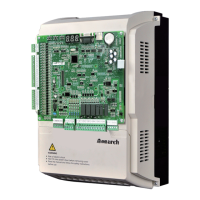3 Peripheral Devices and Options
-
98
-
The following two formulas can be obtained:
K × Pr = Pb × D = U × U/R × D
Pr = (U × U × D)/(R × K)
The regen. resistor power is calculated accordingly.
resistor does not get overheated. The K value can be increased appropriately on the
condition of good dissipation and should not exceed 50%. Failure to comply may re-
Braking frequency (D) is determined by application. Typical values of braking frequen-
Application Elevator
Winding and
unwinding
Centrifuge
Occasional
braking load
General
application
Braking
Frequency
20% to
30%
20% to 30% 50% to 60% 5% 10%
■
Selection guide of regen. resistor
Selection of braking components of the NICE3000
new
Controller Model
Power of
Applicable
Motor (kW)
Max.
Resistance
of Regen.
Min.
Resistance
of Regen.
Power
(W)
Braking Unit
NICE-L-C-2002 1.1 145.0 125.0 300
Built-in
NICE-L-C-2003 1.5 105.0 90.0 450
220-NICE-L-C-4007 2.2 72.0 63.0 600
220-NICE-L-C-4011 3.7 43.0 37.0 1100
220-NICE-L-C-4015 4.0 40.0 35.0 1200
220-NICE-L-C-4018
5.5 29.0 25.0 1600
220-NICE-L-C-4018F
220-NICE-L-C-4022
11.0 18.0 16.0 3500
Built-in
220-NICE-L-C-4022F
220-NICE-L-C-4030
15.0 13.0 13.0 4500
220-NICE-L-C-4030F

